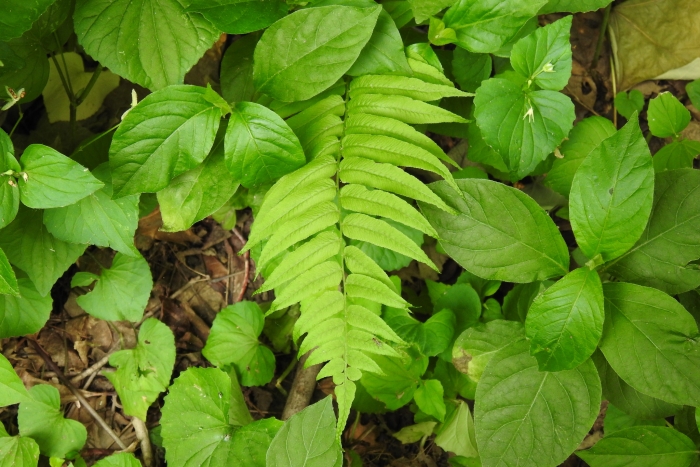Glade Fern
(Homalosorus pycnocarpos)
Glade Fern (Homalosorus pycnocarpos)
/
/

Ben Meredyk
CC BY 4.0
Image By:
Ben Meredyk
Recorded By:
Copyright:
CC BY 4.0
Copyright Notice:
Photo by: Ben Meredyk | License Type: CC BY 4.0 | License URL: http://creativecommons.org/licenses/by/4.0/ | Rights Holder: Ben Meredyk | Publisher: iNaturalist | Date Created: 2021-05-22T14:45:48-07:00 |
















































Estimated Native Range
Summary
Homalosorus pycnocarpos, commonly known as Glade Fern, is a deciduous perennial herb native to rich, moist woods and shaded ravines in the Eastern United States and Ontario. It typically grows from creeping rhizomes with clustered, arching fronds reaching about 90 cm (35 in) in length and 15–20 cm (6–8 in) in width. The fronds are bright green and have a delicate texture, which adds a light, airy feel to shaded garden areas. Glade Fern is appreciated for its ability to thrive in shady conditions where other plants may struggle.
Glade Fern is valued for its lush foliage and adaptability to deep shade, making it an excellent choice for woodland gardens, shaded borders, and naturalized areas. It is also used to stabilize soil in shaded slopes. This fern prefers consistently moist, well-drained soil rich in organic matter and thrives in part shade to full shade. While it is generally low-maintenance, it can suffer from issues such as rust or leaf spot in overly wet conditions. It is not known for aggressive roots or invasiveness, making it a safe choice for most garden settings.CC BY-SA 4.0
Glade Fern is valued for its lush foliage and adaptability to deep shade, making it an excellent choice for woodland gardens, shaded borders, and naturalized areas. It is also used to stabilize soil in shaded slopes. This fern prefers consistently moist, well-drained soil rich in organic matter and thrives in part shade to full shade. While it is generally low-maintenance, it can suffer from issues such as rust or leaf spot in overly wet conditions. It is not known for aggressive roots or invasiveness, making it a safe choice for most garden settings.CC BY-SA 4.0
Plant Description
- Plant Type: Fern
- Height: 2-3 feet
- Width: 2-3 feet
- Growth Rate: Moderate
- Flower Color: N/A
- Flowering Season: Non-Flowering
- Leaf Retention: Deciduous
Growth Requirements
- Sun: Part Shade, Full Shade
- Water: Medium, High
- Drainage: Medium
Common Uses
Border Plant, Deer Resistant, Low Maintenance, Rabbit Resistant, Water Garden
Natural Habitat
Rich, moist woods and shaded ravines
Other Names
Common Names: Narrow-Leaved Glade Fern, Narrow-Leaved Spleenwort, Athyrie À Sores Denses, Diplazie À Sores Denses, Narrow-Leaved Gladefern
Scientific Names: , Diplazium pycnocarpon, Homalosorus pycnocarpos, Athyrium pycnocarpon, Athyrium angustifolium, Asplenium angustifolium, Asplenium pycnocarpon, Diplaziopsis pycnocarpa, Diplaziopsis pycnocarpos, Diplazium angustifolium
GBIF Accepted Name: Homalosorus pycnocarpos (Spreng.) Pic.Serm.